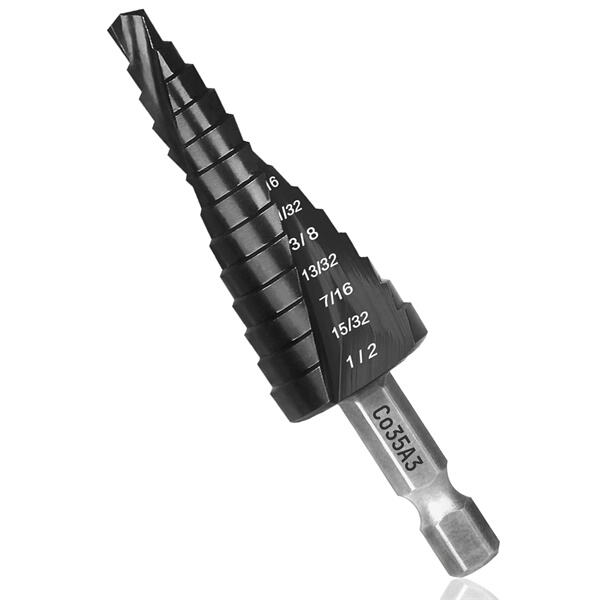هل تواجه صعوبة في حفر الفولاذ المقاوم للصدأ؟ هل تنكسر رؤوس الحفر لديك دائمًا أو تجد صعوبة مع المعدن القوي؟ لا تقلق! هنا يأتي دور Huazhichun لمساعدتك مع رؤوس الحفر المصممة خصيصًا للفولاذ المقاوم للصدأ. وباستخدام رؤوس الحفر الخاصة بنا، يمكنك إكمال عملك دون أي مشاكل!
الصلب غير القابل للصدأ هو أحد أصعب المواد حفرًا لأنه صلب وقوي. هذه القدرة هي السبب في أن العديد من الأشياء تبدو تعمل بشكل جيد معه، مثل الأجهزة المنزلية والأدوات. لكن هذا يعني أيضًا أنه يجب عليك استخدام قطعة حفر مناسبة لتخفيف عملية الحفر. أفضل قطع الحفر الخاصة بالصلب غير القابل للصدأ في طريقها إليك من هوازهيتشون! قطع الحفر لدينا متينة وذات جودة عالية، لذا ستصمد لفترة أطول مقارنة بقطع الحفر غير المتخصصة التي تم تصنيعها فقط لهذه المهمة. يمكنك الوثوق بقطع الحفر الخاصة بنا لأداء أفضل وتجربة حفر أكثر سلاسة.
اختيار مثقاب من الفولاذ المقاوم للصدأ يمكن أن يكون سهلاً (للمواد العادية!) أو حقاً مليئاً بالتحدي بناءً على التكنولوجيات المختلفة. اختر مثقابًا بحجم مناسب لحجم الثقب الذي تريد حفره: إذا كان المثقاب صغيرًا جدًا، فلن يكون الحجم كافيًا، وإذا كان كبيرًا جدًا فإنه يصبح غير مريح. الشيء الثاني الذي يجب أن تأخذه في الاعتبار هو طول المثقاب. يجب أن يكون طويلًا بما يكفي ليخترق سمك الفولاذ المقاوم للصدأ دون صعوبة. وأخيرًا، اختر المثقاب المناسب. المثاقب المصنوعة من الكربيد التنغستن أو الكوبالت مناسبة للفولاذ المقاوم للصدأ. فهي مصممة للمواد الأكثر تحديًا وستؤدي عملًا أفضل.
إذا كنت تريد تبسيط عملية الحفر أثناء العمل مع الفولاذ المقاوم للصدأ، فإن النصائح التالية ستساعدك. الخطوة الأولى: قم بضبط السرعة باستخدام مثقاب. إذا كانت السرعة بطيئة جدًا، فقد تسخن البتات وتتآكل. وإذا كانت السرعة سريعة جدًا، فقد تنكسر البتات. الميزان الأمثل هو المفتاح! ثانيًا، استخدام مواد التشحيم أيضًا قرار حكيم عندما يتعلق الأمر بالحفر. من المهم إبقاء رأس الحفر باردًا، وهذا يساعد أيضًا في تقليل الاحتكاك مما يؤدي إلى عملية حفر أكثر سلاسة. وأخيرًا، يجب أن تضغط باستمرار وتأكد من أن رأس الحفر يكون عموديًا تمامًا على السطح الذي تقوم بحفره. هذا سيحمي البت من الانحناء أو الكسر.

عند حفر الفولاذ المقاوم للصدأ، فإن كاربيد التنجستن والكوبلت هما نوعان شائعان من رؤوس الحفر. يستخدم كاربيد التنجستن لتحقيق صلابة ومتانة عالية جدًا، مما يسمح له بقطع المواد الأقوى مثل الفولاذ المقاوم للصدأ بسهولة. يتطلب الحفر باستخدامه ضغطًا أقل، مما يجعله سهل الاستخدام. من ناحية سلبية، يمكن أن تكون رؤوس الحفر المصنوعة من كاربيد التنجستن أكثر تكلفة مقارنة بأنواع أخرى. أما رؤوس الحفر المصنوعة من الكوبلت فهي أرخص، وهي فولاذ أداة تحتوي على نسبة منخفضة من السبائك، وتؤدي عملًا أفضل على الفولاذ المقاوم للصدأ. وعلى الرغم من أنها ليست قوية أو طويلة الأمد كما هي الحال مع رؤوس كاربيد التنجستن، إلا أنها لا تزال تعمل بشكل جيد نسبيًا للمهمة.

عند العمل مع الفولاذ المقاوم للصدأ، فإن إحدى المشكلات الشائعة التي نواجهها هي كسر رؤوس الحفر. لتجنب هذا السيناريو، تأكد من أن رؤوس الحفر ذات جودة عالية ومصنوعة خصيصًا للفولاذ المقاوم للصدأ. استخدم دائمًا رؤوس حفر بالحجم المناسب وال윤.chomp المناسب. تأكد من أن لديك سرعة حفر مناسبة للعمل وكذلك الضغط المناسب. وأخيرًا، احرص دائمًا على أن يكون رأس الحفر عموديًا بشكل موحد ضد المادة التي تعمل عليها. القيام بهذا سيمنع انحناء الرأس وكسره.

يُخبرك RPM أو "عدد الدورات في الدقيقة" بمدى سرعة دوران حفرتك أثناء التشغيل. تأكد من استخدام RPM المناسب أثناء الحفر في الفولاذ المقاوم للصدأ، وإلا ستسخن رؤوس الحفر وتتكسر. نوصي باستخدام سرعة 1,500 RPM لحفر ثقوب أصغر من 1/8 بوصة باستخدام رؤوس الحفر المصنوعة من كربيد التنجستن من Huazhichun. أما بالنسبة للثقوب التي تتراوح بين 1/8 بوصة و1/2 بوصة، نوصي باستخدام سرعة أبطأ تبلغ 750 RPM. بالنسبة لرؤوس الحفر الكوبالتية، فإن الثقوب الأصغر من 1/8 بوصة يُفضل حفرها بسرعة 1,000 RPM، بينما الثقوب التي تتراوح بين 1/8 بوصة وثقب مكافئ لـ 1/2 بوصة يُفضل حفرها بسرعة 500 RPM.